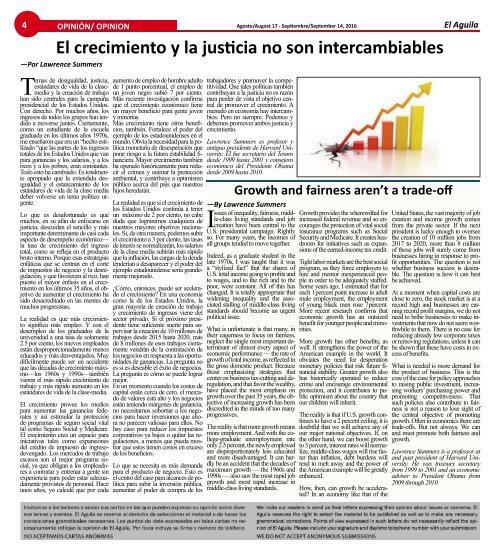El Aguila Magazine – August 17, 2016
Create successful ePaper yourself
Turn your PDF publications into a flip-book with our unique Google optimized e-Paper software.
4 OPINIÓN/ OPINION Agosto/Augost <strong>17</strong> - Septiembre/September 14, <strong>2016</strong> <strong>El</strong> <strong>Aguila</strong><br />
<strong>El</strong> crecimiento y la justicia no son intercambiables<br />
—Por Lawrence Summers<br />
Temas de desigualdad, justicia,<br />
estándares de vida de la clasemedia<br />
y la creación de trabajo<br />
han sido centrales para la campaña<br />
presidencial de los Estados Unidos.<br />
Con derecho. Por muchos años, los<br />
ingresos de todos los grupos han tendido<br />
a moverse juntos. Ciertamente,<br />
como un estudiante de la escuela<br />
graduada en los últimos años 1970s,<br />
me enseñaron que era un “hecho estilizado<br />
“que las partes de los ingresos<br />
totales de los Estados Unidos que van<br />
para ganancias y los salarios, y a los<br />
ricos y a los pobres, eran constantes.<br />
Todo esto ha cambiado. Es totalmente<br />
apropiado que la extendida desigualdad<br />
y el estancamiento de los<br />
estándares de vida de la clase media<br />
deber volverse un tema político urgente.<br />
Lo que es desafortunado es que<br />
muchos, en su afán de enfocarse en<br />
justicia, descuidan el sencillo y más<br />
importante determinante de casi cada<br />
aspecto de desempeño económico—<br />
la tasa de crecimiento del ingreso<br />
total, como se refleja en el producto<br />
bruto interno. Porque esas estrategias<br />
enfáticas que se centran en el corte<br />
de impuestos de negocio y la desregulación,<br />
y que favorecen al rico, han<br />
puesto el mayor énfasis en el crecimiento<br />
en los últimos 35 años, el objetivo<br />
de aumentar el crecimiento ha<br />
sido desacreditado en las mentes de<br />
muchos progresistas.<br />
La realidad es que más crecimiento<br />
significa más empleo. Y con el<br />
desempleo de los graduados de la<br />
universidad a una tasa de solamente<br />
2.5 por ciento, los nuevos empleados<br />
están desproporcionadamente menos<br />
educados y más desventajados. Muy<br />
difícilmente puede ser un accidente<br />
que las décadas de crecimiento máximo—los<br />
1960s y 1990s—también<br />
vieron el más rápido crecimiento de<br />
trabajo y más rápido aumento en los<br />
estándares de vida de la clase-media.<br />
<strong>El</strong> crecimiento provee los medios<br />
para aumentar las ganancias federales<br />
y así estimular la protección<br />
de programas de seguro social vital<br />
tal como Seguro Social y Medicare.<br />
<strong>El</strong> crecimiento crea un espacio para<br />
iniciativas tales como expansiones<br />
del crédito de impuesto de ingresodevengado.<br />
Los mercados de trabajo<br />
escasos son el mejor programa social,<br />
ya que obligan a los empleadores<br />
a contratar y entrenar a gente sin<br />
experiencia para poder estar adecuadamente<br />
provistos de personal. Hace<br />
unos años, yo calculé que por cada<br />
aumento de empleo de hombre adulto<br />
de 1 punto porcentual, el empleo de<br />
un joven negro subió 7 por ciento.<br />
Más reciente investigación confirma<br />
que el crecimiento económico tiene<br />
un mayor beneficio para gente joven<br />
y minorías.<br />
Más crecimiento tiene otros beneficios,<br />
también. Fortalece el poder del<br />
ejemplo de los estadounidenses en el<br />
mundo. Obvia la necesidad para la política<br />
monetaria de desesperación que<br />
pone riesgo a la futura estabilidad financiera.<br />
Mayor crecimiento también<br />
ha operado históricamente para reducir<br />
el crimen y animar la protección<br />
ambiental, y contribuye a optimismo<br />
público acerca del país que nuestros<br />
hijos heredarán.<br />
La realidad es que si el crecimiento de<br />
los Estados Unidos continúa a tener<br />
un máximo de 2 por ciento, no cabe<br />
duda que lograremos cualquiera de<br />
nuestros mayores objetivos nacionales.<br />
Si, de otra manera, podemos subir<br />
el crecimiento a 3 por ciento, las tasas<br />
de interés se normalizarán, los salarios<br />
de la clase media subirán más rápido<br />
que la inflación, las cargas de la deuda<br />
tenderían a desaparecer y el poder del<br />
ejemplo estadounidense seria grandemente<br />
mejorado.<br />
¿Cómo, entonces, puede ser acelerado<br />
el crecimiento? En una economía<br />
como la de los Estados Unidos, la<br />
gran mayoría de creación de trabajo<br />
y crecimiento de ingresos viene del<br />
sector privado. Si el próximo presidente<br />
tiene suficiente suerte para supervisar<br />
la creación de 10 millones de<br />
trabajos desde 2015 hasta 2020, más<br />
de 8 millones de esos trabajos ciertamente<br />
vendrán de la contratación de<br />
los negocios en respuesta a las oportunidades<br />
de ganancias. La pregunta no<br />
es si es deseable el éxito de negocios.<br />
La pregunta es cómo se puede lograr<br />
mejor.<br />
En un momento cuando los costos de<br />
capital están cerca de cero, el mercado<br />
de valores está alto y los negocios<br />
están teniendo márgenes de ganancia,<br />
no necesitamos sobornar a los negocios<br />
para hacer inversiones que ahora<br />
no parecen valiosas para ellos. No<br />
hay caso para reducir los impuestos<br />
corporativos ya bajos o quitar las regulaciones,<br />
a menos que pueda mostrar<br />
que estos tienen costos en exceso<br />
de los beneficios.<br />
Lo que se necesita es más demanda<br />
para el producto de negocio. Esto es<br />
el centro del caso para alcances de política<br />
para subir la inversión pública,<br />
aumentar el poder de compra de los<br />
trabajadores y promover la competitividad.<br />
Que tales políticas también<br />
contribuyan a la justicia no es razón<br />
para perder de vista el objetivo central<br />
de promover el crecimiento. A<br />
menudo en economía hay intercambios.<br />
Pero no siempre. Podemos y<br />
debemos promover ambos justicia y<br />
crecimiento.<br />
Lawrence Summers es profesor y<br />
antiguo presidente de Harvard University.<br />
Él fue secretario del Tesoro<br />
desde 1999 hasta 2001 y consejero<br />
económico del Presidente Obama<br />
desde 2009 hasta 2010.<br />
Growth and fairness aren’t a trade-off<br />
—By Lawrence Summers<br />
Issues of inequality, fairness, middle-class<br />
living standards and job<br />
creation have been central to the<br />
U.S. presidential campaign. Rightly<br />
so. For many years, the incomes of<br />
all groups tended to move together.<br />
Indeed, as a graduate student in the<br />
late 1970s, I was taught that it was<br />
a “stylized fact” that the shares of<br />
U.S. total income going to profits and<br />
to wages, and to the rich and to the<br />
poor, were constant. All of this has<br />
changed. It is totally appropriate that<br />
widening inequality and the associated<br />
stalling of middle-class living<br />
standards should become an urgent<br />
political issue.<br />
What is unfortunate is that many, in<br />
their eagerness to focus on fairness,<br />
neglect the single most important determinant<br />
of almost every aspect of<br />
economic performance — the rate of<br />
growth of total income, as reflected in<br />
the gross domestic product. Because<br />
those emphasizing strategies that<br />
center on business tax-cutting and deregulation,<br />
and that favor the wealthy,<br />
have placed the most emphasis on<br />
growth over the past 35 years, the objective<br />
of increasing growth has been<br />
discredited in the minds of too many<br />
progressives.<br />
The reality is that more growth means<br />
more employment. And with the college-graduate<br />
unemployment rate<br />
only 2.5 percent, the newly employed<br />
are disproportionately less educated<br />
and more disadvantaged. It can hardly<br />
be an accident that the decades of<br />
maximum growth — the 1960s and<br />
1990s — also saw the most rapid job<br />
growth and most rapid increase in<br />
middle-class living standards.<br />
Growth provides the wherewithal for<br />
increased federal revenue and so encourages<br />
the protection of vital social<br />
insurance programs such as Social<br />
Security and Medicare. It creates headroom<br />
for initiatives such as expansions<br />
of the earned-income tax credit.<br />
Tight labor markets are the best social<br />
program, as they force employers to<br />
hire and mentor inexperienced people<br />
in order to be adequately staffed.<br />
Some years ago, I estimated that for<br />
each 1 percent point increase in adult<br />
male employment, the employment<br />
of young black men rose 7 percent.<br />
More recent research confirms that<br />
economic growth has an outsized<br />
benefit for younger people and minorities.<br />
More growth has other benefits, as<br />
well. It strengthens the power of the<br />
American example in the world. It<br />
obviates the need for desperation<br />
monetary policies that risk future financial<br />
stability. Greater growth also<br />
has historically operated to reduce<br />
crime and encourage environmental<br />
protection, and it contributes to public<br />
optimism about the country that<br />
our children will inherit.<br />
The reality is that if U.S. growth continues<br />
to have a 2 percent ceiling, it is<br />
doubtful that we will achieve any of<br />
our major national objectives. If, on<br />
the other hand, we can boost growth<br />
to 3 percent, interest rates will normalize,<br />
middle-class wages will rise faster<br />
than inflation, debt burdens will<br />
tend to melt away and the power of<br />
the American example will be greatly<br />
enhanced.<br />
How, then, can growth be accelerated?<br />
In an economy like that of the<br />
United States, the vast majority of job<br />
creation and income growth comes<br />
from the private sector. If the next<br />
president is lucky enough to oversee<br />
the creation of 10 million jobs from<br />
20<strong>17</strong> to 2020, more than 8 million<br />
of those jobs will surely come from<br />
businesses hiring in response to profit<br />
opportunities. The question is not<br />
whether business success is desirable.<br />
The question is how it can best<br />
be achieved.<br />
At a moment when capital costs are<br />
close to zero, the stock market is at a<br />
record high and businesses are earning<br />
record profit margins, we do not<br />
need to bribe businesses to make investments<br />
that now do not seem worthwhile<br />
to them. There is no case for<br />
reducing already low corporate taxes<br />
or removing regulations, unless it can<br />
be shown that these have costs in excess<br />
of benefits.<br />
What is needed is more demand for<br />
the product of business. This is the<br />
core of the case for policy approaches<br />
to raising public investment, increasing<br />
workers’ purchasing power and<br />
promoting competitiveness. That<br />
such policies also contribute to fairness<br />
is not a reason to lose sight of<br />
the central objective of promoting<br />
growth. Often in economics there are<br />
trade-offs. But not always. We can<br />
and must promote both fairness and<br />
growth.<br />
Lawrence Summers is a professor at<br />
and past president of Harvard University.<br />
He was treasury secretary<br />
from 1999 to 2001 and an economic<br />
adviser to President Obama from<br />
2009 through 2010.
















